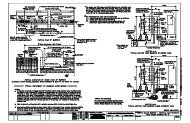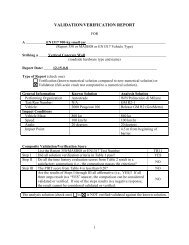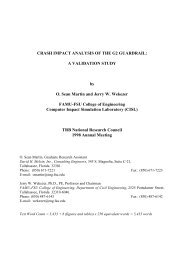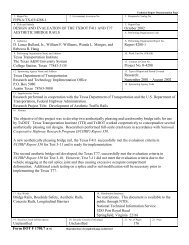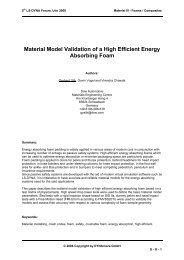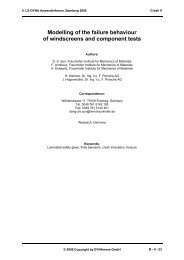Vehicle Crashworthiness and Occupant Protection - Chapter 3
Vehicle Crashworthiness and Occupant Protection - Chapter 3
Vehicle Crashworthiness and Occupant Protection - Chapter 3
You also want an ePaper? Increase the reach of your titles
YUMPU automatically turns print PDFs into web optimized ePapers that Google loves.
Finite Element Analytical Techniques<br />
<strong>and</strong> Applications to Structural Design<br />
the explicit integration algorithm means that the integration timestep must be<br />
smaller then or equal to an upper bound value given as the Courant condition:<br />
lc<br />
∆ t ≤<br />
(3.2.2.1)<br />
c<br />
saying that the analysis timestep should not exceed the smallest of all element<br />
timesteps determined by dividing the element characteristic length through the<br />
acoustic wave speed through the material of which the element is made. The<br />
requirement is equivalent to saying that the numerical timestep of the analysis<br />
must be smaller than, or equal to, the time needed for the physical stress wave to<br />
cross the element. For typical automotive applications using mild steel elements<br />
(c= 5000 m/s) with a characteristic length of 5 mm, this results in an analysis time<br />
step of 1 microsecond. Due to this restriction, it is clear that explicit methods are<br />
best suited to treat problems of short duration <strong>and</strong> thus, high loading velocity<br />
<strong>and</strong> problems of a highly nonlinear nature that require small timesteps for accuracy<br />
reasons. It is again the rapid hardware development in the mid-1980s that has<br />
propelled automotive crash, a 100 ms phenomenon, in the realm of explicit analysis.<br />
3.2.3 Shell Element<br />
The shell element that has been, <strong>and</strong> still remains, the basis of all crashworthiness<br />
simulations is the 4-noded Belytschko <strong>and</strong> Tsay shell. [32-34]. Because this is a<br />
bilinearly interpolated isoparametric element, the lowest order of interpolation<br />
functions available is used. The element is underintegrated in the plane: there is<br />
a single integration point in the center of the element. Treatment of elasto-plastic<br />
bending problems is made possible by the definition of a user-defined number of<br />
integration points through the thickness of the element, all placed along the<br />
element normal in the element center. For computation, the use of an<br />
underintegrated formulation is very efficient. In most cases, it is faster to compute<br />
four underintegrated elements than it is to treat a single fully integrated element<br />
with four integration points. This is due to certain symmetries in the straindisplacement<br />
matrix that arise in the case of underintegrated finite elements.<br />
The use of low order interpolation functions <strong>and</strong> a single in-plane integration<br />
point are the main reasons for the remarkable computational efficiency of the<br />
Belytschko <strong>and</strong> Tsay shell element. The drawback of the underintegration is that<br />
a number of zero-energy or hourglass modes exist in the element. Due to the<br />
simplifications in the evaluation of the element strain-displacement matrix, certain<br />
deformation modes result in a zero-strain calculation, <strong>and</strong> consequently, no stresses<br />
<strong>and</strong> nodal forces are calculated. This means that the nodal velocities can easily<br />
<strong>and</strong> rapidly diverge towards infinity as long as they remain parallel to the hourglass<br />
Page 121



